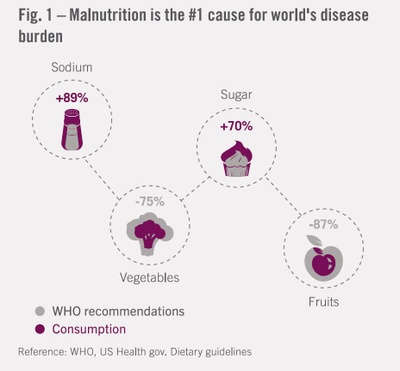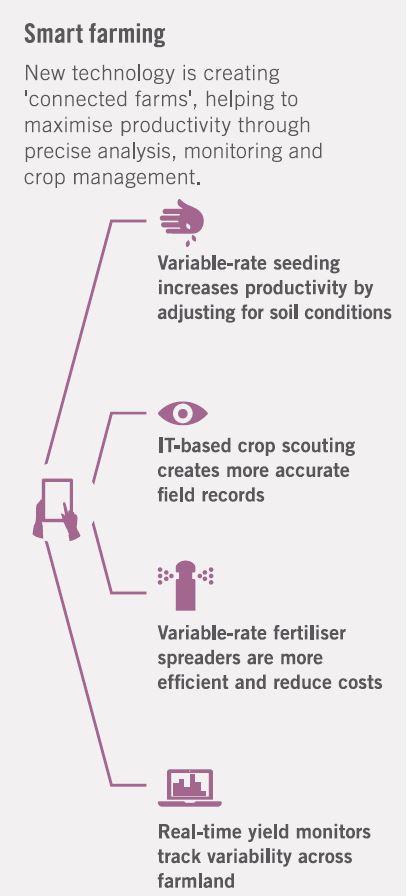Topic of the month September 2017: The future of food
Pictet’s View – The Future of Food
Preserving Nutrition from Farm to Fork
Malnutrition – either eating too little, or too much – is on the top social burdens of our time, erasing 3.5 trillion from global GDP annually. By 2025 it is estimated that one fifth of the global population will be obese. Vast investment is needed to provide a growing global population with nutritionally high-quality food and deliver this in an efficient and sustainable way.
Until recently, advances in farming productivity and food distribution have disproportionately focused on producing calories, with little regard for quality. This has led to increased consumption of processed food, with unintended consequences – most notably the excess consumption of sugar, widely regarded as a major cause of the increase in global obesity levels. Global hunger, poor nutrition and obesity are costing the world trillions of dollars in healthcare and lost productivity.

This is why across the globe people – and governments – are demanding higher quality food, which is produced in a more transparent way. In both developed and developing countries, there is increasing scrutiny on how diets affect people’s quality of life, and this is changing global consumption patterns. In North America, for instance, organic foods are increasingly moving into the mainstream, where sales in the region grew by over 10 per cent in 2014 to almost USD 40 billion.
Nutrient loss is not just averted through better efficiency in the supply chain, but also through fortifying foods with nutrients, improving awareness through better labels and even modernizing food safety regulations. In both developed and emerging countries, a greater focus on health is changing consumer and regulatory attitudes towards improving the nutritional content of food. Companies involved in this transition through the development of high-quality food products, whether that be through better ingredients, reformulation, testing, quality control or certification, are all set to benefit from the growing global focus on health, sourcing and treatment of food.
Access to nutrition
The way we eat has also changed drastically over the last decades. Eating away from home has become the new normal, driving growth in food services and distribution.
At the same time, digitalization means consumers are shifting their habits. Standard retail stores find their margins increasingly under pressure – as replenishment purchases currently represent between 30 and 40 per cent of shopping habits, much of which will likely be done online in the future. This shift will mean retail stores will have to focus on food as an experience rather than a service.
Nowhere is change more necessary than when it comes to increasing efficiency to reduce waste.
Every year, food loss amounts to an estimated economic cost of USD 750 billion. With food losses occurring during harvest, processing, transport and storage, there are many opportunities for companies to increase efficiency. Innovations include anti-microbial packaging that helps to prevent damage during transport and maintain food safety, while innovative sensors on food packaging can help avoid confusion about ‘use-by dates’, reducing the vast amount of food thrown away by consumers.
Sustainable food chains
Agriculture is the largest user of critical resources – water, energy and land – and, as such, will be at the forefront of innovations designed to use them more efficiently. Sustainable intensification is required in order for us to produce more food from the same land with less environmental impact.
Much of the food needed to meet the growing global population's demands can be provided by improving efficiency along the food production chain. From farm to fork, over a billion tons of food is wasted each year. A more efficient food supply chain could support demand without incurring greater environmental costs.
Dealing with this will be a major challenge, but it also represents an opportunity for companies able to provide solutions, such as precision monitoring tools enabling the accurate application of fertilisers to correct soil imbalances.

Globally, consumers are demanding nutritionally higher-quality food and querying its source and treatment, creating major challenges in food cultivation, storage and distribution.
Ultimately, bringing food from farm to fork efficiently, while reducing waste along the way, will be of crucial importance to fostering the future of our food system.
|
About Pictet Asset Management Pictet Asset Management is a specialist asset manager offering investment solutions and services to investors around the world. Today we manage EUR 162 billion of assets across a broad range of equity, fixed income, alternatives and multi-asset strategies. Our mission is to build lasting partnerships with our clients by exceeding their expectations for investment performance and service. Our clients include some of the world’s largest pension funds, sovereign wealth funds and financial institutions. We are part of the Pictet Group, founded in Geneva in 1805, which also specialises in Wealth Management and Asset Services. Privately owned and managed by six partners, the Pictet Group has more than 3,900 employees in 26 offices around the world. All data as at 30 June 2017 |




